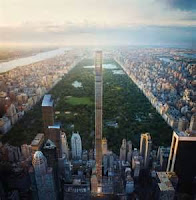You could live here... but if the cost doesn't kill you, the commute might.
Yeah, it could be a touch pricey at $100 mil (plus annual upkeep charges of $150-200,000 per year) but you have to admit, not having to mow the lawn could be worth it. The commute however, is another story.
 |
| Mumbai Tower |
You're talking about the equivalent of one full work week of elevator rides, not counting that bratty kid downstairs who runs in and presses all the buttons before you can stop him. And if you have varicose veins, bad feet and/or claustrophobia, you learn money can't buy you everything.
Despite the thought that living high is the exclusive option of the very rich and bold, especially because your building looks like a thin stick high in the air, subject to wind, violent storms and clouds, it is the elevator itself that imposes strict limitations on viability.
 |
| 111 W 57th St. NYC |
Tall buildings hold their own fascination. Tallest today is the beautiful Burj Kahlifa in Dubai rising about half-mile into the clouds. But that will soon be eclipsed two or three times in the next five years. A building today, because of innovations in elevators and a better understanding of the laws of nature, could be a mile high. How would you like to live on floor 357? What a ride that would be.
Elevators, the biggest drawback to date, will soon be able to travel up, down and sideways at rapid speed, with multiple cars in the same channel, as maglev technology comes into play. These cars will speed along on rails using counter-affecting magnets that allows them to travel on a thin cushion of air... no more cables and lots more control!
Architects have also come to understand that putting counter-weights at the top of such buildings reduces sway and a feeling of "seasickness" and unease... but maybe not for me. Fortunately, being 'much less than rich' has its benefits. Counter weights can be anywhere from 300 to 800 tons apiece. That's the equivalent of 100 African elephants or 20 tractor-trailers or 20 humpback whales or 6 Boeing 787's. How's that for wow factor?
 | ||
| So you like high? How's this for someone who builds those tall things. (Photo from NYTimes weekly magazine.) |
Tall and ultra-tall buildings are majestic and awesome but good architecture at any level is like a symphony. All one has to do to enjoy is visit Columbus, Indiana. This city of 45,000 just south of Indianapolis has many attributes but perhaps the greatest is that it is the home of the Cummins Engine Company. Its Chairman of many years ago, the late J. Irwin Miller, launched a charitable foundation that helped subsidize a large number of building projects in the city... churches, homes, office buildings, parks and the like, by-up-and coming engineers and architects. Columbus is visited annually by architectural students and tourists for its wealth of beautiful structures throughout. It is designated a National Historic Landmark by The National Park Service and is well worth the trip.
Every great architect is--necessarily--a poet. He (she) must be
a great interpreter of his time, his day, his age.
Frank Lloyd Wright
We shape our buildings; thereafter, they shape us.
Winston Churchill
The mother of art is architecture. Without an architecture
of our own we have no soul of our own civilization.
Frank Lloyd Wright






No comments:
Post a Comment